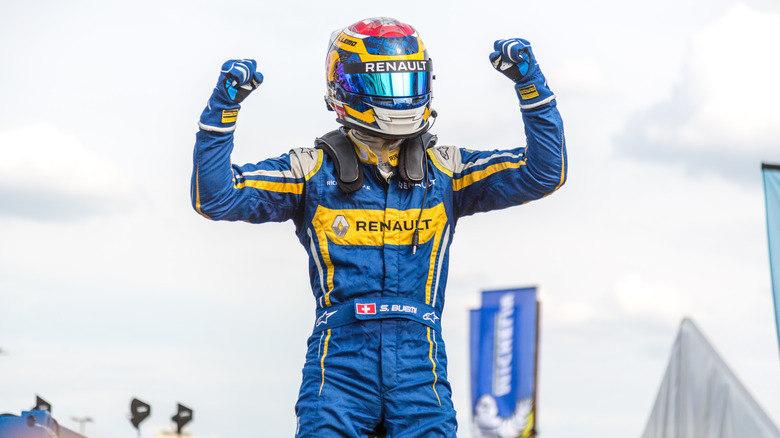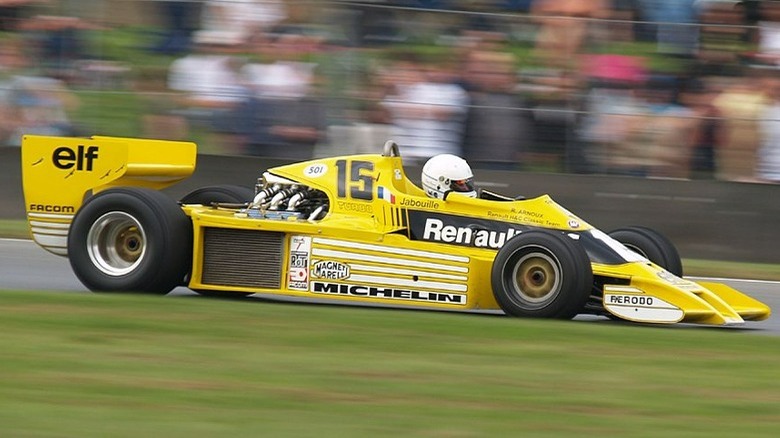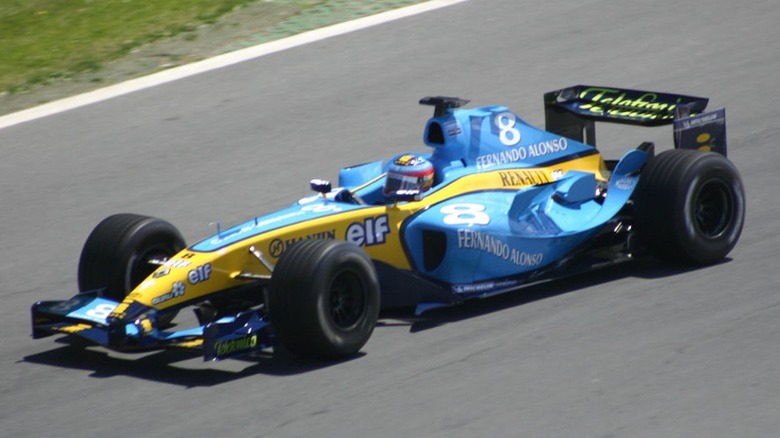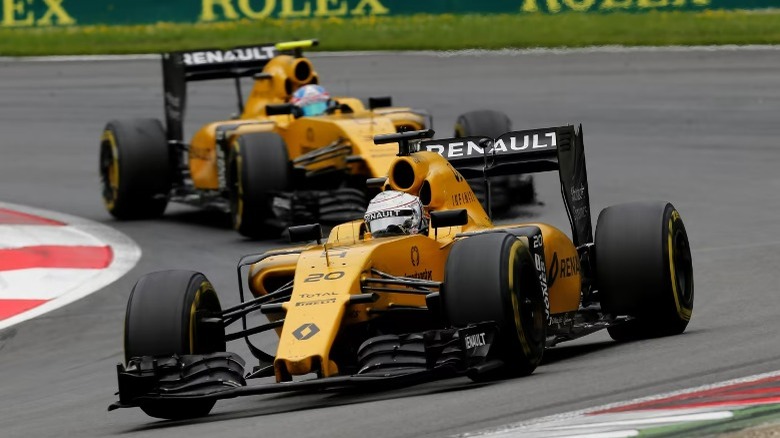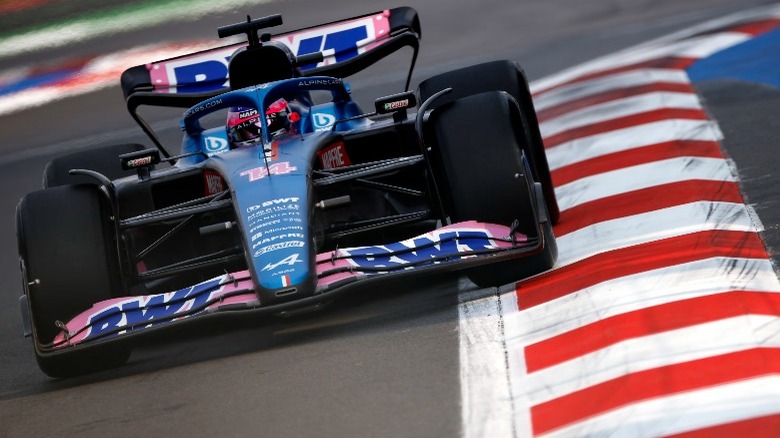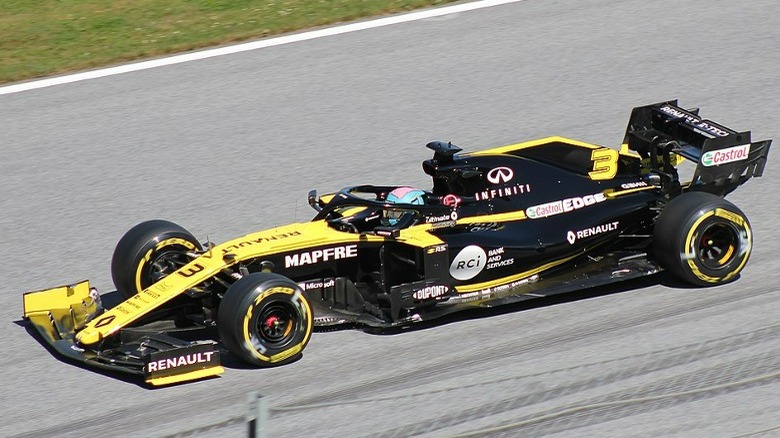The Top 5 Best Renault Liveries Ever, Ranked
Renault has racing coursing through its veins. The French automotive manufacturer began life as a platform to build sporting vessels. In 1898, Louis Renault's direct-drive transmission entered the world, and the Type A Voiturette, utilizing this innovation, was the first to successfully climb Montmartre Hill. Shortly after, in 1902, Renault's first engine, the Type K, was deployed in the winning vehicle during the Paris-Vienna race.
Then, in 1973, Renault became the majority shareholder in another French manufacturer, Alpine (with which crossover 'collaborations' have continued to pour out into the public sphere). This acquisition would put Renault on the path to where it is today, as the Alpine Formula 1 team. Shortly thereafter, Renault made strides toward competition within the Formula 1 world, and in 1977, began competing with the "Yellow Teapot" as its first racer. Yellow liveries have dominated the Renault ranks ever since, but these aren't the only color patterns that have adorned the team's fast-paced vehicles. These are some of the five Renault liveries that have ever taken to the track, from the teapot that started it all to the modern iterations of Renault yellow and Alpine blends.
Renault's first Formula 1 car, 1977's RS01
When Renault's 1977 RS01 took to the track at Silverstone, it was a historic day. The racing vehicle was the first Formula 1 car to utilize a turbocompressed engine. The car is historic, and the livery that Renault applied to the vehicle is equally renowned. The car offers an open look at the rear engine compartment, with the chassis covering the top section of this space behind the driver, but stopping before it rolls over the back end. This exposes the silver components of the engine and adds a unique visual dimension to the car as a whole.
In addition to the design of the vehicle, the color scheme is completed by a trio of yellow (the primary shade across the entire body) stripes, white racing streaks across each side, and a black stripe around the cockpit that showcases the Renault logo in contrasting white text. As a result of engine trouble on the track, the Renault car would often emanate white smoke, leading Ken Tyrrell, chief of the Tyrrell racing team to jokingly refer to the RS01 as the "Yellow Teapot." The endearing and somewhat belittling nickname stuck, and so has Renault's classic yellow chassis.
[Featured image by Darren via Wikimedia Commons | Cropped and scaled | CC BY 2.0]
The 2004 R24's yellow and blue collaboration
2004 was the precursor to immense success within the Renault camp. 2005 and 2006 saw Fernando Alonso lead Renault to back-to-back Constructors' Cup and Drivers' Championship wins. These victories came off the heels of Renault's return in earnest to the constructor field in 2002 after taking over the Benneton team in 2000.
The 2004 R24 is a shining example of Renault's classic yellow livery mixed in with intense blue highlights, proudly showcasing the brand's French racing heritage alongside its own style. The car is toned down in physicality — it doesn't include the halo that's become a mandatory safety feature on Formula 1 cars since 2018. The vehicle is all muscle and style, with a gentle rolling chassis that rises up gradually to the rear tailfin. To complement the bodywork, Renault's livery incorporates the yellow flashes running from the nose and along each side of the frame. The top is all-blue, along with the side pods.
[Featured image by TMWolf via Wikimedia Commons | Cropped and scaled | CC BY-SA 2.0]
The R.S.16 of 2016's Formula 1 season
The R.S.16 that powered Renault through the 2016 Formula 1 season was a disappointment when it came to the car's performance. The Renault team returned to Formula 1 this year, taking over the Lotus Works team. This was Renault's first season back after a five-year hiatus, and the growing pains certainly showed in the results: Finishing the season in ninth place overall with drivers Kevin Magnussen and Jolyon Palmer taking 16th and 18th place with seven and one driver points scored, respectively.
While the transition year was tough on the drivers and pit team, one feature that shone brightly throughout the season was the livery of the team's cars. The Lotus livery during the prior year was a black and red vehicle that was certainly sleek, but Renault's iconic yellow exterior is a far prettier affair. Worth noting, however, is that the R.S.16 doesn't sport a true, bright yellow like the 2019 iteration. Rather, the 2016 Renault car is more of a golden yellow. Still, the tone dominates the car's livery, with black lettering doing most of the heavy lifting when it comes to adding contrast through numbering and sponsorship iconography. The tail — taking on a black paint job — is lettered in white, completing the assembly magnificently.
2022 A522 Alpine skin
In 2021, Renault was rebranded as the Alpine Formula 1 team, and in addition to the name change, the livery was revamped. Instead of the dramatic yellow that has often played a central role in Renault color schemes, the new Alpine team has taken on the French racing blue livery as its primary tone. In 2021, the Alpine car was decked out in a shiny, blue shade that was attractive to the eye, but remained somewhat subdued. 2022 saw a shift to more striking blue shades across the body, as well as pink highlights on the nose assembly and tail fin. "The French blue is stunning, especially under floodlights," writes Simon Ostler for Goodwood.
The pink highlights come along with a prominent placement of BWT logos, which became the title sponsor of the Alpine racing team for 2022. Previously, BWT ("Best Water Technology"), an Austrian water treatment systems manufacturer, sponsored Force India (and then Racing Point) and was the primary driver behind the pink liveries of the outfit. The final livery developed for Alpine's A522 in 2022 was a combination of BWT's pink highlights and the dominant French national racing tone that flows together beautifully.
2019 R.S.19's pristine yellow and black
The most striking Renault livery on this list has to be the combined yellow and black effort put forth on the Formula 1 circuit in 2019. The R.S.19, driven by Daniel Ricciardo and Nico Hulkenberg, was hailed by Cyril Abiteboul (the team principal) as "perhaps the strongest on the grid," according to Formula 1.
While the team ultimately finished in fifth position among the ten racing teams in the paddock, the car itself remains a standout among the field. The car sports a streamlined yellow stripe running from the front tip of the nose back to the cockpit. Then, from the middle section of the vehicle onward the yellow centerline narrows to highlight three slim racing stripes that extend the rest of the body to the back edge. They are positioned along the topline of the vehicle, and directly on either side of the driver. Sponsorship logos are placed within these edge lines along the side of the vehicle, as well as elsewhere on the R.S.19. The rest of the Formula 1 racer is drenched in lustrous black, completing the vessel. The black and yellow combination found in 2019 is the most dramatic to date and highlights the team's style to perfection.
[Featured image by Lukas Raich via Wikimedia Commons | Cropped and scaled | CC BY-SA 4.0]
